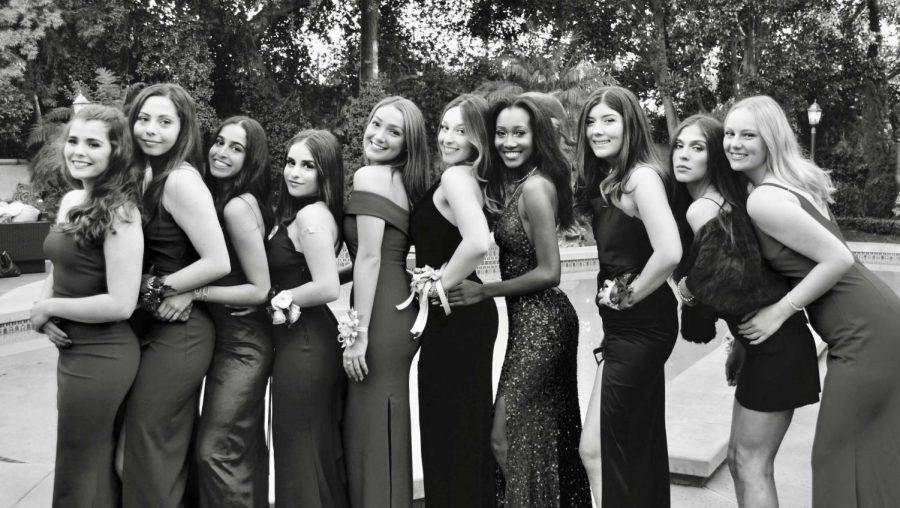Zoo prom location sparks controversy
“I thought about wearing fur, but I decided it wouldn’t be in good taste,” said Cierra Thompson ‘19.
As Tologs stood in line watching their wide-eyed dates get patted down by a few bulky security guards, they collectively took a deep breath in, the distinct smell of manure tickling their noses. After a short ride past the reptile exhibit and into the zoo, girls stepped out of the three-car tram and shook hands with Sister Celeste and Mrs. Singer. They then entered the red and white tents surrounding a fashionable dance floor.
Students know prom as the event of the year, a time when they can let go and enjoy themselves. This year’s prom, called “The Greatest Prom” a la “The Greatest Showman,” took place at the LA Zoo. There were circus-like tents, cotton candy and soft pretzels.
Charlotte Taormina ‘19 said she “really enjoyed prom, especially the carousel. It was super quirky and fun!”
Although many Tologs were excited, the conversation surrounding animal rights was polarizing. Zoos, including the LA Zoo, have a long history of controversy over animal mistreatment.
“I didn’t want to go to prom because… my family and I do not support places that trap animals and that have harmed animals in the past, and the LA Zoo has, in fact, harmed elephants,” Cate Ziegler ‘20 said.
The administration took note of these anxieties.
“[The senior board] heard one to two comments about the concern about what a zoo is, but we felt that the area where we were was near the carousel and not actually inside the zoo. I kind of get the argument, but no one brought that to our attention. That wasn’t a concern by the seniors who chose that venue,” said Ms. Carol Jones, faculty advisor to the senior board.
Ms. Christine Wheaton, who is currently doing a masters program in conservation biology in partnership with the San Diego Zoo, does not feel as though the LA Zoo should have been a controversial location.
“[The LA Zoo] is a member of the AZA, and they have very strict standards for animal welfare… Most [of the animals] have off-exhibit areas where they sleep. Also if they are really sensitive to the noise, they are often kept in off-exhibit areas as well,” said Wheaton.
To get more information on the possible harms of zoos, the Veritas Shield contacted People for the Ethical Treatment of Animals, commonly referred to as PETA. Unlike Wheaton, Tracy Reiman, the Vice President of PETA, sees zoos as a means to unjustly hold animals in captivity.
Reiman told me that the LA Zoo “is an inappropriate place to hold an event” like prom.
“Holding an event at a zoo with hundreds of rowdy teenagers is not ever going to be in the best interests of the animals,” Reiman said.
PETA believes that “at the end of the day animals should not be held for human amusement.” PETA recognizes the work the LA Zoo has done to help animals, but it stands by their stance “animals should not be held in captivity.”
Although animals were not being paraded through prom, zoo-like features lined the walls, literally: zebra-print lighting illuminated the ceiling, bathrooms were surrounded by trees and picnic tables were tucked into plants.
The legal history of the LA Zoo’s track record of elephant abuse made for an uneasy juxtaposition with the elephant mural that girls posed in front of for photos.
In 2007, Aaron Leider and Robert Culp, both residents of Los Angeles, sued John Lewis, the former director of the Los Angeles Zoo, for its mistreatment of three of its Asian elephants, Billy, Tina and Jewel.
Leider and Culp argued that the LA Zoo was abusing their elephants, which are technically public property. They claimed that the city’s abuse of the animals created an illegal and wasteful expenditure of public funds.
David Casselman, the lead counsel of Leider and Culp, a seasoned animal rights attorney and founder of the Cambodia Wildlife Sanctuary, told me that “the LA Zoo professes to be a huge advocate for animals, and in particular Asain Elephants. I learned that 16 elephants have died — or in my view, have been killed by the zoo.”
In 2012, the trial court issued an order forcing the LA Zoo to stop using bullhooks and electric shocks as behavioral training methods and ordered the zoo to allow the elephants at least two hours of activity a day on soft ground to protect their feet.
But then, in 2017, the California Supreme Court reversed the Court of Appeals’ decision on a technicality. The elephants stayed in the LA Zoo and, according to Casselman, today are being treated with electric shock and bullhorn.
Unfortunately, the attorney who defended the LA Zoo did not respond to the Veritas Shield’s attempt for an interview. The LA Zoo has been very vocal about its conservation efforts.
Wheaton described the change in efforts coming from zoos more broadly. “The focus [of zoos] has shifted a lot towards conservation education and conservation activities, so really helping conserve animals that are in many cases extinct or critically endangered in the wild.”
Although many girls looked forward to prom, some chose not to attend. In total, 157 tickets were sold. Country music festival Stagecoach took place that weekend, which many Tologs attended.
Some Tologs were worried about the venue for practical reasons.
“Some girls said, ‘Oh this is at the zoo, is my dress going to get dirty?’ Which I thought was hilarious, but I get the concern because you want to have a good time at the event you don’t want to be wondering if you are going to be dirty,” Cramer said.

